
Various Thai drinks are waiting for you to discover ahead. Thanks to a tropical climate, the country has a diverse range of Thai fruits to make into refreshing beverages. Furthermore, some of these refreshments possess a unique taste tailored to the local fruits.
If you’re looking for some spirits, Thailand also has a few alcoholic options for you to experience. In addition, the article will also provide you with the necessary information about the location to find these phenomenal refreshments. So stick around and read!
Non Alcoholic Thai Beverages
As one of the titans of fruit exporting, it’s not a surprise that Thai locals rely heavily on local fruits for their drinks. Furthermore, you may also find some Thai variations of famous beverages in this compilation of alcohol-free drinks. Without further ado, let’s jump into it.
1. Nam Manao (Lime Juice)
Non-alcoholic
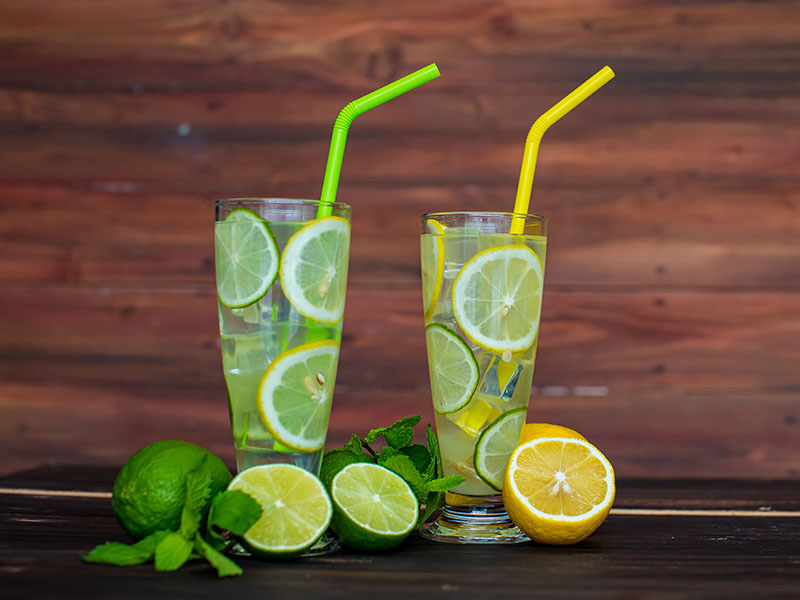
Let’s start with an easy and familiar refreshment, everyone’s favorite lemonade. In Thailand, Nam Manao is the name of a glass of lime juice that consists of lime, sugar, and water. The concoction brings a refreshing taste to its consumers in the tropical heat.
The simple combination of lime and sugar is also a beloved choice in the Vietnamese list of beverages; the concoction frequently goes by the name of Nước Chanh. Sometimes, locals even sprinkle a pinch of salt to improve the overall taste.
Commonly, people enjoy Nam Manao as a cold drink with plentiful ice to beat the heat. Thanks to the tangy taste of lemon, Nam Manao is ideal for pairing with many spicy Thai curry delicacies to lower the heat.
Where To Find: At any local stalls, vendors, or restaurants across Thailand.
2. Nom Yen (Thai Pink Milk Tea)
Non-alcoholic
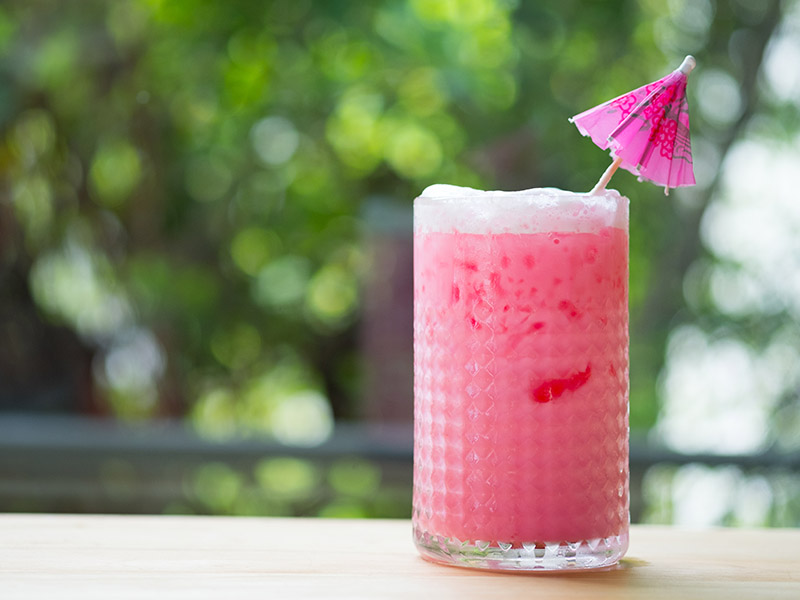
In Thai, the direct translation of Nom Yen is pink milk. The beverage is essentially an attractive Thai sweet treat with a unique pink color from the inclusion of sala syrup. The sweetener is a synthetic blend of sala (a type of palm fruit) with sugar and water that has a striking red color.
Nom Yen is especially popular for children; therefore, vendors will often sell this type of pink milk in front of schools. In addition to the sala syrup, you also need a milk blend between evaporated milk and sweetened condensed milk.
It’s best to enjoy Nom Yen as a refreshing glass of milk to beat the summer heat as locals do in Thailand. Plus, you can easily adjust the color and overall sweetness by calibrating the amount of sala syrup.
Where To Find: Thai food stalls or vendors standing around school areas.
Uncover the more exciting ways to execute Nom Yen right at home.
3. Coconut Water
Non-alcoholic
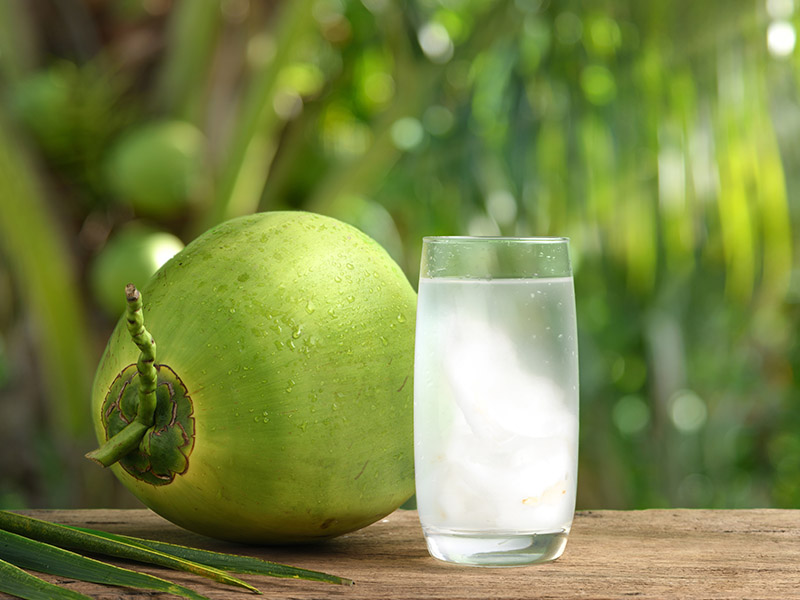
There is nothing better than enjoying the fruit and satisfying your thirst simultaneously on hot days. With coconut water, you can achieve both as it is a famous option for Thai locals to beat the heat during summer.
Coconut water is rich in various minerals that help you recover faster after a long walk or exercise. There’re not many secrets when it comes to making coconut water, as you can just chop off the top of the fruit to get to the water.
However, I suggest you go further by splitting the coconut in half to get to the flesh. Interestingly, various flavorful Thai side dishes use coconut meat as a garnish. Commonly, Thai locals pick young coconut for sweet water with a fleshy meat texture resembling raw fish.
In some cases, you can even sprinkle in a pinch of salt for a more balanced taste. Better yet, people even add pandan leaves for a more fragrant coconut water with a generous amount of ice.
Where To Find: At local stores, restaurants, and street vendors. The bottled version of coconut water is widely available at convenience stores.
4. Cha Yen (Thai Iced Tea)
Non-alcoholic

Cha Yen has to be one of the most iconic drinks in Thailand, with a creamy milk flavor and a strong tea essence. Many believe that one of the Thai leaders was the first to invent Cha Yen. You can easily identify Cha Yen through its vibrant orange color.
Traditionally, people have to brew black tea before incorporating milk and various spices. Nowadays, Thai locals simply use the package Cha Yen which contains all the necessary seasonings to mix with sugar and cream.
If you want to use pure black tea, add star anise, cardamom pod, and cloves to spice up the mixture. Then, stir the concoction with half and half until you get the desired color. Cha Yen is amazing when consumed with a copious amount of ice.
Where To Find: At local markets, food stalls, or motorcycle vendors.
Cha Yen is unskippable if you want a refreshing tea drink.
5. Nam Thabthim (Pomegranate Juice)
Non-alcoholic
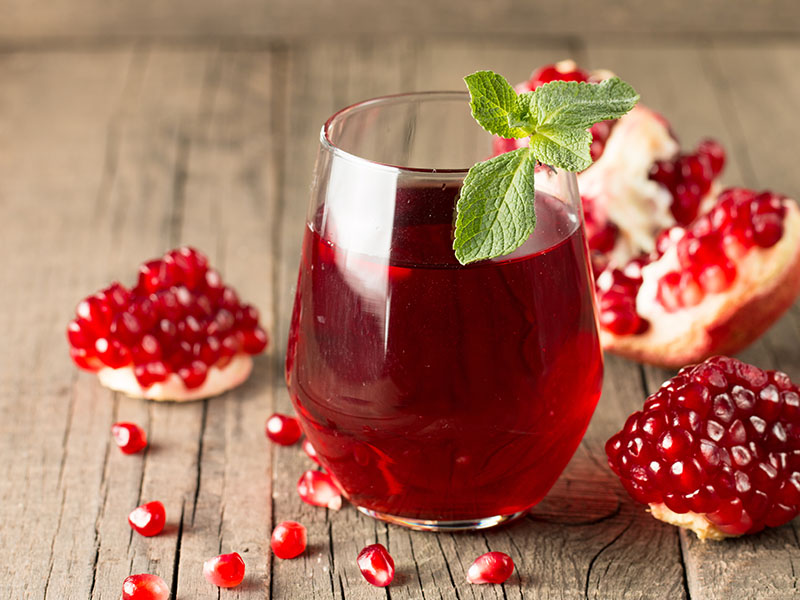
Nam Thabthim is the Thai version of refreshing pomegranate juice widely available across the country. The refreshment is a Thai fan-favorite choice as pomegranates supply a decent amount of vitamin C in every glass.
In many Thai markets, the locals make Nam Thabthim right in front of you to ensure optimal freshness. Once they finish blending the pomegranate, the mixture needs to go through a strainer to remove any unwanted sediment from the seeds.
If you’re grabbing Nam Thabthim from vendors, there’s a high chance that it’s a bottled version of pomegranate juice. Therefore, you want to look for food stalls for the best quality Nam Thabthim.
Where To Find: Nam Thathim is available at many food stalls, restaurants, and vendors.
6. Nam Oy (Sugarcane Juice)
Non-alcoholic

Aside from coconut water, Nam Oy or sugarcane juice is a popular option to quench your thirst while discovering mouthwatering Thai specialties on hot days. Instead of going for drinks with artificial sweeteners, you should be sipping on Nam Oy.
Sugarcane is abundant in Thailand, so it shouldn’t be a problem for you to encounter Nam Oy at local food stalls or vendors. Thanks to a naturally sweet flavor, Thai people love to infuse the juice with a touch of sourness to bring the refreshment to a perfect balance.
Typically, locals feed the sugarcane through a special machine to extract all the juice. On average, Nam Oy is cheaper than other drinks since it takes little effort to make.
Where To Find: At food stalls across Thailand.
Take a closer look at how vendors pump out constant Nam Oy from their stalls.
7. Krating Daeng (Thai Red Bull)
Non-alcoholic

Do you need an instant kick of energy to keep you on your feet? In Thailand, locals often turn to Krating Daeng to get the required rush. I know the name may sound strange to many people, but Krating Daeng is just a Thai version of the red bull energy drink.
Although you can easily find red bull back in the home country, this Thai variation is unique because of the lack of carbonation. Krating Daeng often comes in a small glass bottle that might look like cough syrup for some individuals.
As for the taste, Krating Daeng hits you with a huge amount of sugar that sometimes puts people into a sugar rush sensation. Don’t worry; the effect of red bull tends to wear off after a couple of hours.
Where To Find: Krating Daeng is everywhere in Thailand, especially in convenience stores.
8. Milo Chocolate Drink
Non-alcoholic

If Westerners are acquainted with hot chocolate, then children in Thailand are head over heels for Milo, a chocolate powder malted product. The drink is inseparable from the Thai breakfast menu because many parents believe Milo provides their kids with sufficient nutrients.
Although Milo is an Australian-originated beverage, Thai people are more than happy to incorporate the chocolate powder mix into their cuisine.
Milo is a brown powder with a nice vanilla aroma in its original form. Most often, parents mix the Milo powder with sweetened condensed milk and regular warm milk to make the drink more resemble hot chocolate. In addition, they even garnish the glass with a sprinkle of Milo.
Where To Find: Milo is accessible at any store or supermarket across Thailand.
9. Chao Kuai (Grass Jelly Drinks)
Non-alcoholic

Grass jelly is a favored treat in many Asian countries, including Thailand. Many believe that the dessert originates from China. Most often, grass jelly has a deep black color with a texture that resembles regular gelatin.
In Thailand, Chao Kuai is versatile as it can accompany a wide range of beverages like tea, sodas, or juices. Locals cut the Chao Kuai into small cubes, so it’s easier to serve along with your choice of drinks.
To make the grass jelly from scratch, locals utilize the packaged grass jelly powder to mix with boiling water and some pandan leaves. Cut the gelatin into small squares once the mixture is set and transfer it to a serving glass with milk (or any beverage you like).
Where To Find: Chao Kuai appears at almost every Thai market or dessert stall.
Grass jelly is surprisingly easy for a homemade refreshing treat.
10. Nam Matoom (Thai Bael Fruit Tea)
Non-alcoholic
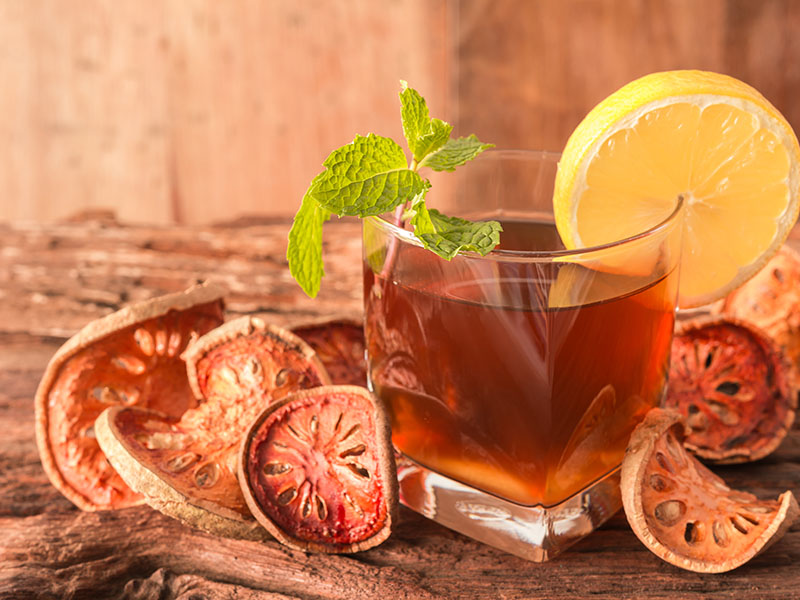
Nam Matoom or more commonly known as bael fruit tea is a wonderful Thai beverage that takes little effort to make. Although bael is a type of fruit, many Thais see Nam Matoom as a herbal drink to enhance their health.
First, people usually burn the bael slightly to bring out more fragrance and infuse the fruit with a smokey taste. Next, you want to boil the bael slices in water to extract all the goodness. Ideally, the bael should be tender, and you can adjust the sweetness with a touch of sugar.
You may have noticed that there are no actual tea leaves in this authentic Thai recipe. However, because of the natural orange-brown color, Thai people often use the word “tea” to describe this drink.
Where To Find: At Thai local restaurants, café shops, or convenience stores as a bottled version.
11. Oliang (Thai Iced Coffee)
Non-alcoholic
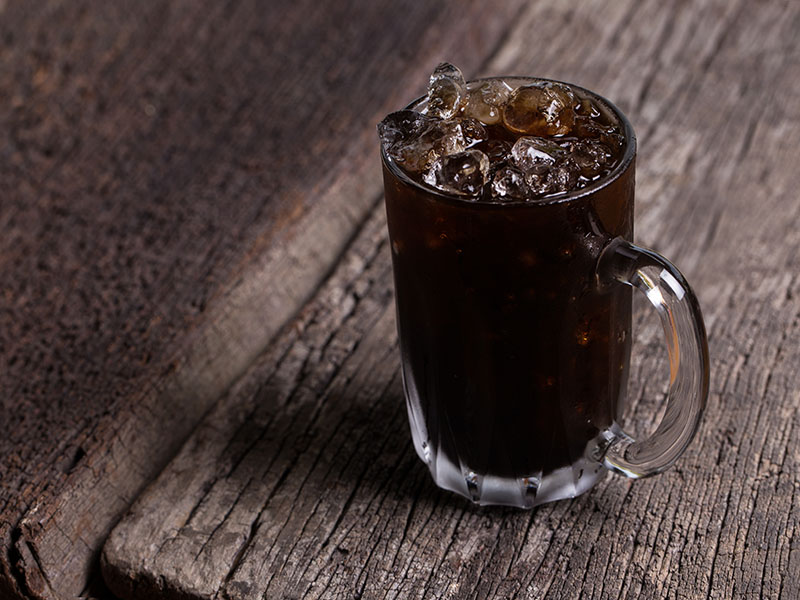
Coffee is a well-established drink worldwide, and Thailand also adopted the beverage into people’s lives. Most Thai coffee beans are Arabica varieties with a sweet taste and a hint of sweetness. If you’re looking to order a pure glass of black coffee, use the word Oliang.
The name is a combination of “O” for black while “Liang” refers to cold.
Most often, Thais grind fresh Arabica beans into a powder to brew up an intense caffeine concoction using hot water. You can drink Oliang with ice or add milk for a milder taste. Some may say that Oliang resembles Vietnamese coffee, which also shares the signature features.
In Thailand, you want to have some patience while enjoying Oliang since it takes time for the muslin filter to produce a sufficient amount. Each drop of coffee may seem like forever, but it is also the time for you to hold conversations with the locals to understand more about the culture.
Where To Find: Oliang is everywhere across Thailand, such as café stores, local vendors, or restaurants.
Learn more methods that allow you to customize Oliang to your will.
Alcoholic Spirits Of Thailand
Alcohol is also an essential part of Thai culture and reflects a lot about the people of Thailand. Although there are not a lot of iconic representatives for this category, each type of Thai spirit possesses a unique taste that you have to try at least once.
12. Singha (Thai Beer)
Alcoholic
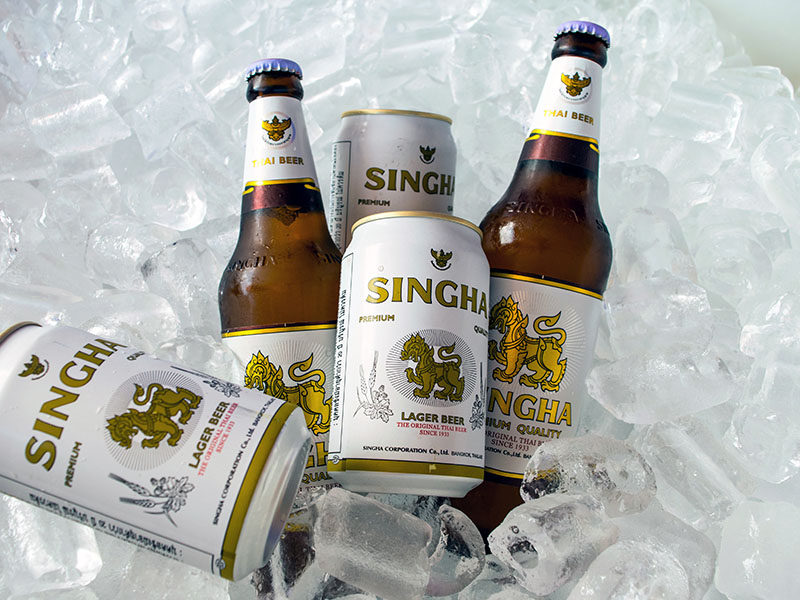
Singha is the most common beer variety you can encounter in almost any corner of Thailand. The alcohol drink is a pale lager that possesses a light yellow color and a strong malty flavor of high-end barley.
The beer has made its ground in Thailand since 1933 and now spreads to over 50 countries worldwide. On average, Singha has around 6% alcohol content which is higher than conventional beers. Most often, people pair Singha with various Thai dishes as bar snacks.
Besides a strong malty taste, Singha also provides consumers with a rich flavor. Commonly, the beer comes in a glass bottle or can with different volumes to satisfy your thirst for alcohol.
Where To Find: At liquor stores, convenience stores, or supermarkets across Thailand.
13. Sang Som (Thai Rum)
Alcoholic
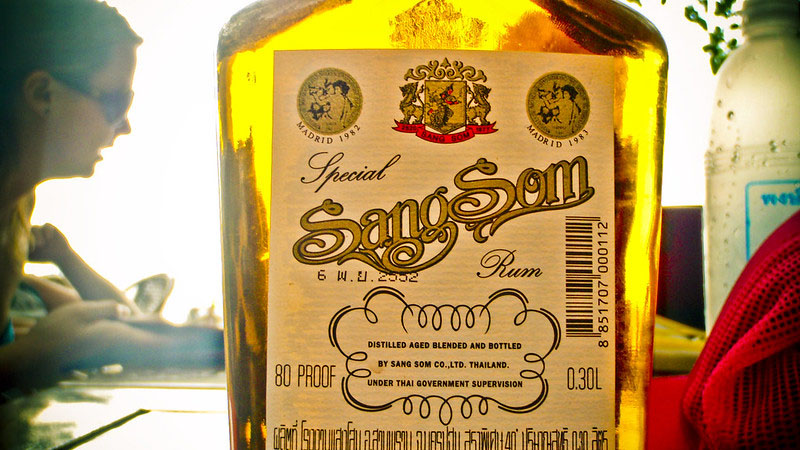
Sang Som is the way to go if you want to taste rum while having a vacation in Thailand.
For many individuals, it may be challenging to find rum in Southeast Asian areas, but Thailand offers a spirit that resembles rum in flavor with the name Sang Som. The spirit is a distilled concoction of sugarcane or molasses with various herbs and spices.
Sang Som first made its appearance in 1977 and has maintained its position as one of the best alcohol brands in the Southeast Asian region.
However, I need to advise you to be careful around Sang Som because with an alcohol level of 40%; you can get drunk after a couple of shots.
Where To Find: At most supermarkets, convenience stores, and bars in Thailand.
If you want to know more about Sang Som, take a peek at this review.
14. Mekhong (Thai Alcohol)
Alcoholic
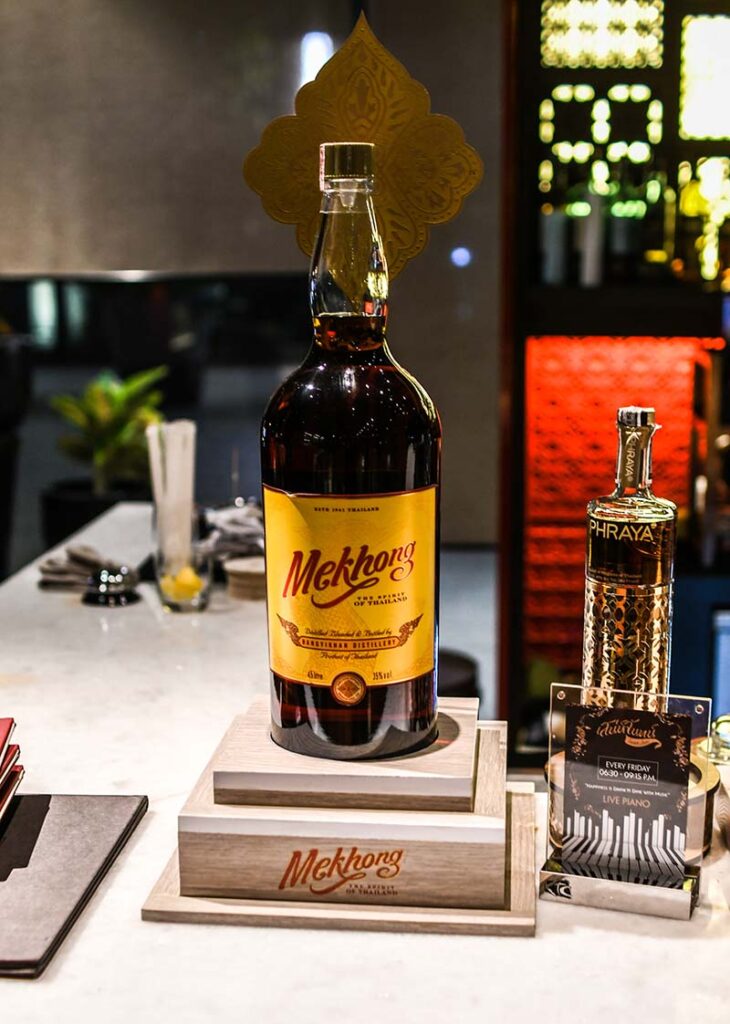
The Mekhong is another Thai spirit that bears some resemblances to the already mentioned Sang Som. People name this particular Thai spirit based on the Mekong river, one of the longest waterways that flows across six countries.
With the introduction of Mekhong in 1941, the spirit has become a staple of Thailand’s delicacy. Although many think Mekhong is a whiskey, the alcoholic beverage is closer to rum with a 35% alcohol content.
Most often, Thai indigenous create Mekhong by combining molasses (95%) with rice (5%). The result is a golden brown concoction with a light bittersweet taste of ginger and orange.
Where To Find: At local bars or pubs, it also appears in many Thai supermarkets.
I know you’re still excited about Mekhong, so learn more about its place in Thailand with this guide.
15. Lao Khao (Thai Spirit)
Alcoholic
Here’s another fascinating Thai spirit that you can explore. The Lao Khao is a distilled alcohol that appeared around the same time as the Mekhong around the 1950s. If you can’t lay your hands on Lao Khao, you should ask locals for Sura Khao (another name for Lao Khao).
Lao Khao also possesses similar ingredients to Mekhong and Sang Som when people mainly use molasses and rice to distill alcohol. As for the alcohol level, Lao Khao contains around 28% to 40%, making it a potent choice.
Typically, Lao Khao has a certain sharpness in flavors and is perfect for pairing with spicy delicacies of Thai cuisine.
Where To Find: At bars, convenience stores, or pubs in Thailand.
16. Sato (Thai Rice Wine)
Alcoholic

Tasting Sato is one way that allows you to understand more about Thai culture and its people.
Wrapping up this Thai drinks compilation is an iconic rice drink of Thailand known as Sato. The spirit has a Northeastern origin and is related to Isan cuisine of its diverse range of foods. The rice drink spreads across Thailand mainly due to the migration of many Isan individuals.
In Northeastern culture, drinking Sato is a custom that reflects the culture of people from the region. Sato consists of a sticky rice base and then fermented thanks to the inclusion of luk paeng, a type of starter culture.
Thai people love drinking Sato as it is a method to maintain their tradition. Locals often serve Sato at room temperature in a huge bowl so the guests can scoop up the concoction by themselves.
Where To Find: In local markets in the Northeastern region of Thailand.
Some Instructions To Prepare Thai Beverages Right At Home
To give you a more in-depth look into the making of Thai refreshments, I’d like to bring you some simple mix to make right at home. I promise these drinks will surely get a new breeze into your house.
1. Nom Yen
Whenever you have left-over milk lying around in the refrigerator, don’t forget to think about making Nom Yen. You can quickly assemble all the ingredients and sip away rich pink milk in less than 15 minutes.
Ingredients: Sala syrup, evaporated milk, and sweetened condensed milk.
Step 1: Measure out the ingredients according to the size of your glass.
Step 2: Stir the ingredients and top the glass with ice.
Step 3: Pour in extra milk over the remaining space and stir for the last time before serving.
Observe how vendors create Nom Yen with simple steps and ingredients.
2. Cha Yen
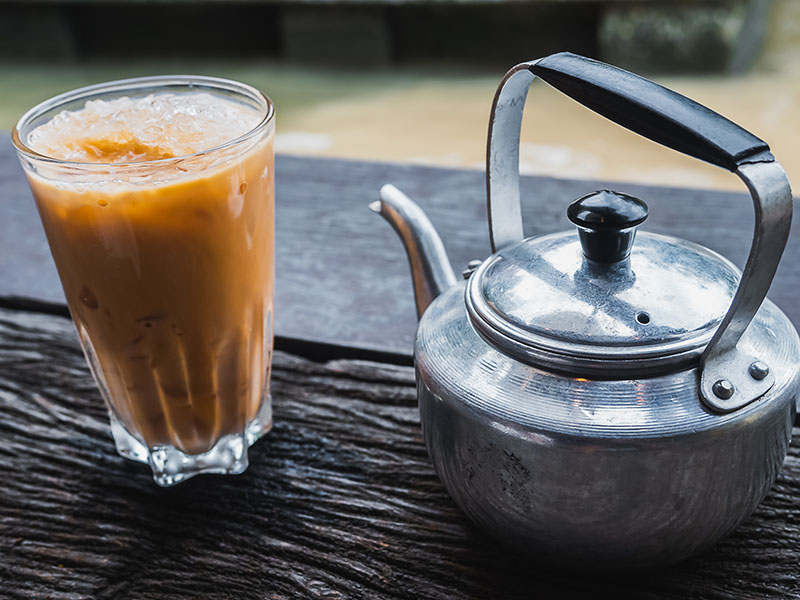
I know many of you guys always have some spare tea around the house. Instead of letting the tea rot away, why not turn it into a delicious Thai-style milk tea. Who knows, Cha Yen may even make you hooked with tea.
Ingredients: Thai tea mix or regular tea bags, water, sugar, half and half, cloves, and cardamom pod.
Step 1: Bring water to a boil for 3 minutes with the tea mix and add some sugar to adjust the flavor.
Step 1.1: If you’re using regular tea bags, make sure to bring the tea to a boil with the addition of cardamom pods and cloves. Gently stir until the sugar has dissolved completely.
Step 2: Let the mixture cool and steep for around 30 minutes.
Step 3: Strain the tea concoction from the leaves and pour in half and half with ice.
3. Nam Manao
It’s always simple to fix yourself a quality glass of lemonade. The same idea also goes for Nam Manao, a super straightforward Thai lemonade. So without further ado, allow me to show you how to make Nam Manao properly.
Ingredients: fresh limes, water, sugar, mint leaves, and a pinch of salt.
Step 1: Cut the lime and squeeze to extract the juice.
Step 2: Dilute the acidic mixture with some water and microwave it for around 6 – 8 minutes.
Step 3: Stir in sugar until fully dissolved.
Step 4: Pour in extra lime juice on top and serve it in a tall glass with a wedge of lime for garnish.
Which Thai Refreshment Is Your Go-To Choice?
What do you think about these drink recommendations? I hope that you find this article helpful for your next vacation in Thailand. In addition, you may even come across many concoctions that utilize these types of refreshments.
If you know of any more unique Thai drinks, please leave a comment and tell everyone about them. This article is also ideal for sending to closed ones so they can pick their preferences on the next trip to Thailand. Thank you for spending your time!
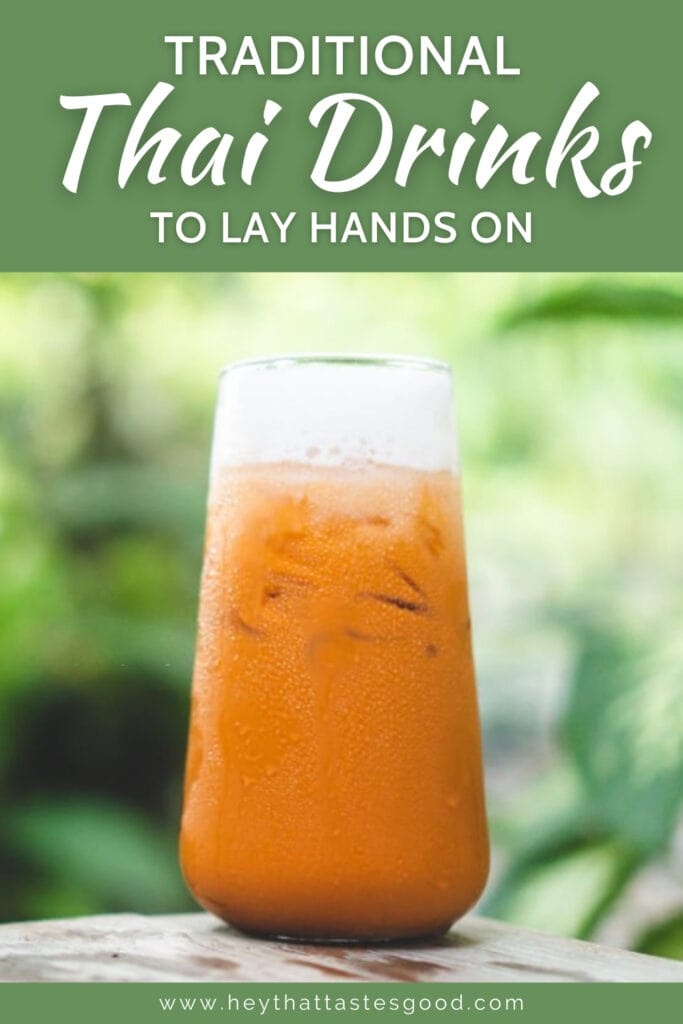


Truc Tran (Kris)
Expertise
Home Cooking, Meal Planning, Recipe Development, Baking and Pastry, Food Editor, Cooking-video Maker, Asian Food Content Creator, Vietnamese Food Evaluation Expert
Education
Program: Diploma of Hospitality (Commercial Cookery)
Focus: The culinary program included a Certificate III in Commercial Cookery, a Certificate IV in Kitchen Management, and a Diploma of Hospitality Management. This education provided a comprehensive blend of theoretical and practical training in finance, sustainability, diversity, and human resources management.
Program: Culinary Arts at Kendall College (Australia Branch in Sydney)
Focus: Explored global cuisines, and developed entrepreneurial abilities to manage a successful food business, along with acquiring essential language, math, computer, and communication skills for success.
Program: Certificate of Vietnamese Cuisine Head Chef
Focus: Master traditional and modern Vietnamese cooking techniques.
Truc Tran, or Kris, is an accomplished food editor with extensive training in hospitality and culinary arts, including a deep focus on Vietnamese cuisine from various prestigious institutions. She possesses over nine years of experience, developing her expertise in global cuisines and blending traditional Vietnamese cooking with contemporary trends to create engaging and educational content.
She also has a rich educational background, including a Diploma of Hospitality from TasTAFE and a Bachelor of Arts in Culinary Arts from Kendall College’s Sydney branch. It enables her to offer unique insights into meal planning, recipe development, and food culture, making her articles and cooking videos both informative and appealing.